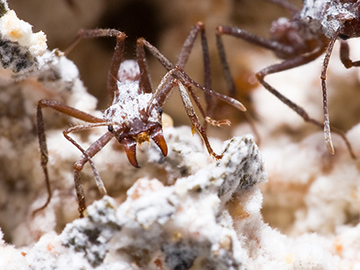 Leaf-cutter ants that cultivate “good” fungus live in symbiosis with bacteria that fight “bad” fungus. The bacteria, seen above as a powdery substance on the ants’ bodies, could lead researchers to much-needed new drugs to fight fungal infections, cancer and parasitic diseases. Image: Cameron Currie/license
Leaf-cutter ants that cultivate “good” fungus live in symbiosis with bacteria that fight “bad” fungus. The bacteria, seen above as a powdery substance on the ants’ bodies, could lead researchers to much-needed new drugs to fight fungal infections, cancer and parasitic diseases. Image: Cameron Currie/license
In the Atlantic Forest of Brazil, leaf-cutter ants carry fresh foliage back to their home colony. There, the partially digested leaves nourish a “garden” of white fungus that the ants cultivate to feed their larvae, their queen and other ants that never leave the nest.
Like human gardeners, the fungus-farming ants must protect their crop from invaders. The parasitic fungus Escovopsis poses a constant threat. Fortunately, the ants have an ally: Pseudonocardia bacteria.
During more than 45 million years of symbiosis with the ants, the bacteria have evolved to produce specific antifungal compounds that kill invading Escovopsis while sparing the good fungus. Many of the ants, meanwhile, have evolved special pockets and glands in their bodies to house and feed their bacterial partners.
A team of scientists from the U.S. and Brazil hopes that studying the compounds these bacteria produce will lead to new drugs that combat invasive fungal infections in people, as well as new treatments for cancer and parasitic diseases.
The idea is rooted in history. Pseudonocardia belongs to a group of actinobacteria that has already provided most of the world’s antibiotics as well as antifungals, antivirals, anti-clotting drugs and more. And the fungus they fight for the ants is related to fungi that cause life-threatening human disease.
To date, no one has gone hunting for natural products—compounds made by living organisms that could serve as or inspire medicines—in the fungus-farming ant ecosystems.
The National Institutes of Health and the State of São Paulo Research Foundation share the scientists’ belief that these ecosystems have medicinal potential. On July 31, they awarded the team $5,154,376 over five years.
“I’m very excited. I think this project has a good chance of success, and I think it aligns ecology and drug discovery in a way that we haven’t tried before,” said Jon Clardy, the Hsien Wu and Daisy Yen Wu Professor of Biological Chemistry and Molecular Pharmacology at Harvard Medical School, who will co-lead the project with medicinal chemist Monica Pupo of the University of São Paulo.
